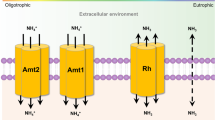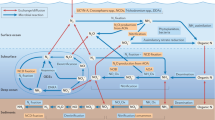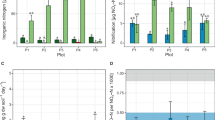Abstract
Microbial activities drive the global nitrogen cycle, and in the past few years, our understanding of nitrogen cycling processes and the micro-organisms that mediate them has changed dramatically. During this time, the processes of anaerobic ammonium oxidation (anammox), and ammonia oxidation within the domain Archaea, have been recognized as two new links in the global nitrogen cycle. All available evidence indicates that these processes and organisms are critically important in the environment, and particularly in the ocean. Here we review what is currently known about the microbial ecology of anaerobic and archaeal ammonia oxidation, highlight relevant unknowns and discuss the implications of these discoveries for the global nitrogen and carbon cycles.
Similar content being viewed by others
Log in or create a free account to read this content
Gain free access to this article, as well as selected content from this journal and more on nature.com
or
References
Arrigo K . (2005). Marine micro-organisms and global nutrient cycles. Nature 437: 349–355.
Barns SM, Delwiche CF, Palmer JD, Pace NR . (1996). Perspectives on archaeal diversity, thermophily and monophyly from environmental rRNA sequences. Proc Natl Acad Sci USA 93: 9188–9193.
Beman JM, Francis CA . (2006). Diversity of ammonia-oxidizing archaea and bacteria in the sediments of a hyper-nutrified subtropical estuary: Bahía del Tóbari, Mexico. Appl Environ Microbiol 72: 7677–7777.
Cantera JJL, Stein JL . (2007). Molecular diversity of nitrite reductase genes (nirK) in nitrifying bacteria. Environ Microbiol 9: 765–776.
Capone DG, Popa R, Flood B, Nealson KH . (2006). Follow the Nitrogen. Science 312: 708–709.
Casciotti KL, Ward BB . (2001). Dissimilatory nitrite reductase genes from autotrophic ammonia-oxidizing bacteria. Appl Environ Microbiol 67: 2213.
Casciotti KL, Ward BB . (2005). Phylogenetic analysis of nitric oxide reductase gene homologues from aerobic ammonia-oxidizing bacteria. FEMS Microbiol Ecol 52: 197–205.
Coolen MJL, Abbas B, Van Bleijswijk J, Hopmans EC, Kuypers MMM, Wakeham SG et al. (2007). Putative ammonia-oxidizing Crenarchaeota in suboxic waters of the Black Sea: a basin-wide ecological study using 16S ribosomal and functional genes and membrane lipids. Environ Microbiol 9: 1001–1016.
Dalsgaard T, Canfield DE, Petersen J, Thamdrup B, Acuna-Gonzalez J . (2003). N2 production by the anammox reaction in the water column of Golfo Dulce, Costa Rica. Nature 422: 606–608.
DeLong EF . (1992). Archaea in coastal marine environments. Proc Natl Acad Sci USA 89: 5685–5689.
Engstrom P, Dalsgaard T, Hulth S, Aller RC . (2005). Anaerobic ammonium oxidation by nitrite (anammox): implications for N2 production in coastal marine sediments. Geochim Cosmochim Acta 69: 2057–2065.
Francis CA, Roberts KJ, Beman JM, Santoro AE, Oakley BB . (2005). Ubiquity and diversity of ammonia-oxidizing archaea in water columns and sediments of the ocean. Proc Natl Acad Sci USA 102: 14683–14688.
Fuhrman JA, McCallum K, Davis AA . (1992). Novel major archaebacterial group from marine plankton. Nature 356: 148–149.
Guven D, Dapena A, Kartal B, Schmid MC, Maas B, van de Pas-Schoonen K et al. (2005). Propionate oxidation by and methanol inhibition of anaerobic ammonium-oxidizing bacteria. Appl Environ Microbiol 71: 1066–1071.
Hallam SJ, Konstantinidis KT, Putnam N, Schleper C, Watanabe Y-i, Sugahara J et al. (2006a). Genomic analysis of the uncultivated marine crenarchaeote Cenarchaeum symbiosum. PNAS 103: 18296–18301.
Hallam SJ, Mincer TJ, Schleper C, Preston CM, Roberts K, Richardson PM et al. (2006b). Pathways of carbon assimilation and ammonia oxidation suggested by environmental genomic analyses of marine crenarchaeota. PLoS Biol 4: e95.
Hamersley MR, Lavik G, Woebken D, Rattray JE, Lam P, Hopmans EC et al (2007). Anaerobic ammonium oxidation in the Peruvian oxygen minimum zone. Limnol Oceanog 52 (in press).
Herndl GJ, Reinthaler T, Teira E, van Aken H, Veth C, Pernthaler A et al. (2005). Contribution of archaea to total prokaryotic production in the deep atlantic ocean. Appl Environ Microbiol 71: 2303–2309.
Ingalls AE, Shah SR, Hansman RL, Aluwihare LI, Santos GM, Druffel ERM et al. (2006). Quantifying archaeal community autotrophy in the mesopelagic ocean using natural radiocarbon. Proc Natl Acad Sci USA 103: 6442–6447.
Karner MB, DeLong EF, Karl DM . (2001). Archaeal dominance in the mesopelagic zone of the Pacific Ocean. Nature 409: 507–510.
Kartal B, Kuypers MMM, Lavik G, Schalk J, Op den Camp HJM, Jetten MSM et al. (2007a). Anammox bacteria disguised as denitrifiers: nitrate reduction to dinitrogen gas via nitrite and ammonium. Environ Microbiol 9: 635–642.
Kartal B, Rattray J, van Niftrik LA, van de Vossenberg J, Schmid MC, Webb RI et al. (2007b). Candidatus ‘Anammoxoglobus propionicus’ a new propionate oxidizing species of anaerobic ammonium oxidizing bacteria. Systematic Appl Microbiol 30: 39–49.
Kirkpatrick J, Oakley B, Fuchsman C, Srinivasan S, Staley JT, Murray JW . (2006). Diversity and distribution of planctomycetes and related bacteria in the suboxic zone of the black sea. Appl Environ Microbiol 72: 3079–3083.
Klotz MG, Arp DJ, Chain PSG, El-Sheikh AF, Hauser LJ, Hommes NG et al. (2006). Complete genome sequence of the marine, chemolithoautotrophic, ammonia-oxidizing bacterium nitrosococcus oceani ATCC 19707. Appl Environ Microbiol 72: 6299–6315.
Könneke M, Bernhard AE, de la Torre JR, Walker CB, Waterbury JB, Stahl DA . (2005). Isolation of an autotrophic ammonia-oxidizing marine archaeon. Nature 437: 543–546.
Kowalchuk GA, Stephen JR . (2001). Ammonia-oxidizing bacteria: a model for molecular microbial ecology. Annu Rev Microbiol 55: 485–529.
Kuypers MMM, Blokker P, Erbacher J, Kinkel H, Pancost RD, Schouten S et al. (2001). Massive expansion of marine archaea during a mid-Cretaceous anoxic event. Science 293: 92–94.
Kuypers MMM, Lavik G, Thamdrup B . (2006). Anaerobic ammonium oxidation in the marine environment. In: Neretin, LN (ed). Past and Present Water Column Anoxia. Springer: Dordrecht, The Netherlands, pp 311–335.
Kuypers MMM, Lavik G, Woebken D, Schmid M, Fuchs BM, Amann R et al. (2005). Massive nitrogen loss from the Benguela upwelling system through anaerobic ammonium oxidation. Proc Natl Acad Sci 102: 6478–6483.
Kuypers MMM, Sliekers AO, Lavik G, Schmid M, Jørgensen BB, Kuenen JG et al. (2003). Anaerobic ammonium oxidation by anammox bacteria in the Black Sea. Nature 422: 608–611.
Leininger S, Urich T, Schloter M, Schwark L, Qi J, Nicol GW et al. (2006). Archaea predominate among ammonia-oxidizing prokaryotes in soils. Nature 442: 806.
Mehta MP, Baross JA . (2006). Nitrogen Fixation at 92°C by a Hydrothermal Vent Archaeon. Science 314: 1783–1786.
Meyer RL, Risgaard-Petersen N, Allen DE . (2005). Correlation between anammox activity and microscale distribution of nitrite in a subtropical mangrove sediment. Appl Environ Microbiol 71: 6142–6149.
Middelburg JJ, Soetaert K, Herman PMJ, Heip CHR . (1996). Denitrification in marine sediments: a model study. Global Biogeochem Cy 10: 661–673.
Mincer TJ, Church MJ, Taylor LT, Preston CM, Karl DM, DeLong EF . (in press). Quantitative distribution of presumptive archaeal bacterial nitrifiers in Monterey Bay the North Pacific Subtropical Gyre. Environ Microbiol. Advance online publication, 12 February 2007; doi:10.1111/j.1462-2920.2006.01227.x.
Mulder A, Graaf AA, Robertson LA, Kuenen JG . (1995). Anaerobic ammonium oxidation discovered in a denitrifying fluidized bed reactor. FEMS Microbiol Ecol 16: 177–184.
Nicol GW, Schleper C . (2006). Ammonia-oxidising Crenarchaeota: important players in the nitrogen cycle? Trends Microbiol 14: 207–212.
Ochsenreiter T, Selezi D, Quaiser A, Bonch-Osmolovskaya L, Schleper C . (2003). Diversity and abundance of Crenarchaeota in terrestrial habitats studied by 16S RNA surveys and real time PCR. Environ Microbiol 5: 787.
Ouverney CC, Fuhrman JA . (2000). Marine planktonic archaea take up amino acids. Applied Environ Microbiol 66: 4829–4833.
Park H-D, Wells GF, Bae H, Criddle CS, Francis CA . (2006). Occurrence of ammonia-oxidizing Archaea in wastewater treatment plant bioreactors Appl. Environ Microbiol 72: 5643–5647.
Pearson A, Huang Z, Ingalls AE, Romanek CS, Wiegel J, Freeman KH et al. (2004). Nonmarine crenarchaeol in Nevada hot springs. Appl Environ Microbiol 70: 5229–5237.
Pearson A, McNichol AP, Benitez-Nelson BC, Hayes JM, Eglinton TI . (2001). Origns of lipid biomarkers in Santa Monica Basin surface sediment: a case study using compound-specific 14C analysis. Geochimi Cosmochim Acta 65: 3123–3137.
Penton CR, Devol AH, Tiedje JM . (2006). Molecular evidence for the broad distribution of anaerobic ammonium-oxidizing bacteria in freshwater and marine sediments. Appl Environ Microbiol 72: 6829–6832.
Philippot L . (2002). Denitrifying genes in bacterial and Archaeal genomes. Biochim Biophys Acta 1577: 355–376.
Purkhold U, Pommerening-Roser A, Juretschko S, Schmid MC, Koops H-P, Wagner M . (2000). Phylogeny of all recognized species of ammonia oxidizers based on comparative 16S rRNA and amoA sequence analysis: implications for molecular diversity surveys. Appl Environ Microbiol 66: 5368–5382.
Revsbech NP, Risgaard-Petersen N, Schramm A, Nielsen LP . (2006). Nitrogen transformations in stratified aquatic microbial ecosystems. Antonie van Leeuwenhoek 90: 361–375.
Richards FA . (1965). Anoxic basins and fjords. In: Ripley, JP and Skirrow G (eds). Chemical Oceanography. Academic Press: London, pp 611–645.
Risgaard-Petersen N, Langezaal AM, Ingvardsen S, Schmid MC, Jetten MSM, Op den Camp HJM et al. (2006). Evidence for complete denitrification in a benthic foraminifer. Nature 443: 93–96.
Risgaard-Petersen N, Meyer RL, Schmid M, Jetten MSM, Enrich-Prast A, Rysgaard S et al. (2004). Anaerobic ammonium oxidation in an estuarine sediment. Aquatic Microbial Ecol 36: 293–304.
Rysgaard S, Glud RN . (2004). Anaerobic N2 production in Arctic sea ice. Limnol Oceanog 49: 86–94.
Rysgaard S, Glud RN, Risgaard-Petersen N, Dalsgaard T . (2004). Denitrification and anammox activity in Arctic marine sediments. Limnol Oceanog 49: 1493–1502.
Schmid MC, Maas B, Dapena A, van de Pas-Schoonen K, van de Vossenberg J, Kartal B et al. (2005). Biomarkers for in situ detection of anaerobic ammonium-oxidizing (Anammox) bacteria. Appl Environ Microbiol 71: 1677–1684.
Schubert CJ, Durisch-Kaiser E, Wehrli B, Thamdrup B, Lam P, Kuypers MMM . (2006). Anaerobic ammonium oxidation in a tropical freshwater system (Lake Tanganyika). Environ Microbiol 8: 1857–1863.
Shimamura M, Nishiyama T, Shigetomo H, Toyomoto T, Kawahara Y, Furukawa K et al. (2007). Isolation of a multiheme protein from an anaerobic ammonium-oxidizing enrichment culture with features of a hydrazine-oxidizing enzyme. Appl Environ Microbiol 73: 1065–1072.
Sinninghe Damste JS, Rijpstra WIC, Hopmans EC, Prahl FG, Wakeham SG, Schouten S . (2002). Distribution of membrane lipids of planktonic crenarchaeota in the arabian sea. Appl Environ Microbiol 68: 2997.
Steunou A-S, Bhaya D, Bateson MM, Melendrez MC, Ward DM, Brecht E et al. (2006). In situ analysis of nitrogen fixation and metabolic switching in unicellular thermophilic cyanobacteria inhabiting hot spring microbial mats. Proc Natl Acad Sci USA 103: 2398–2403.
Strous M, Jetten MSM . (2004). Anaerobic oxidation of methane and ammonium. Annu Rev Microbiol 58: 99–117.
Strous M, Kuenen JG, Jetten MSM . (1999). Key physiology of anaerobic ammonium oxidation. Appl Environ Microbiol 65: 3248–3250.
Strous M, Pelletier E, Mangenot S, Rattei T, Lehner A, Taylor MW et al. (2006). Deciphering the evolution and metabolism of an anammox bacterium from a community genome. Nature 440: 790–794.
Teira E, van Aken H, Veth C, Herndl GJ . (2006). Archaeal uptake of enantiomeric amino acids in the meso- and bathypelagic waters of the North Atlantic. Limnol Oceanography 51: 60–69.
Thamdrup B, Dalsgaard T . (2002). Production of N2 through anaerobic ammonium oxidation coupled to nitrate reduction in marine sediments. Appl Environ Microbiol 68: 1312–1318.
Thamdrup B, Dalsgaard T, Jensen MM, Ulloa O, Farias L, Escribano R . (2006). Anaerobic ammonium oxidation in the oxygen-deficient waters off northern Chile. Limnol Oceanog 51: 2145–2156.
Third KA, Sliekers AO, Kuenen JG, Jetten MSM . (2001). The CANON system (completely autotrophic nitrogen removal over nitrite) under ammonium limitation: interaction and competition between three groups of bacteria. Syst Appl Microbiol 24: 588–596.
Treusch AH, Leininger S, Kletzin A, Schuster SC, Klenk H-P, Schleper C . (2005). Novel genes for nitrite reductase and Amo-related proteins indicate a role of uncultivated mesophilic crenarchaeota in nitrogen cycling. Environ Microbiol 7: 1985–1995.
Trimmer M, Nicholls JC, Deflandre B . (2003). Anaerobic ammonium oxidation measured in sediments along the Thames estuary, United Kingdom. Appl Environ Microbiol 69: 6447–6454.
van der Wielen PWJJ, Bolhuis H, Borin S, Daffonchio D, Corselli C, Giuliano L et al. (2005). The Enigma of prokaryotic life in deep hypersaline anoxic basins. Science 307: 121–123.
Venter JC, Remington K, Heidelberg JF, Halpern AL, Rusch D, Eisen JA et al. (2004). Environmental genome shotgun sequencing of the Sargasso Sea. Science 304: 66–74.
Vetriani C, Jannasch H, MacGregor B, Stahl D, Reysenbach A . (1999). Population structure and phylogenetic characterization of marine benthic Archaea in deep-sea sediments. Appl Environ Microbiol 65: 4375–4384.
Ward BB . (2000). Nitrification and the marine nitrogen cycle. In: Kirchman D (ed). Microbial Ecology of the Oceans. Wiley and Sons: New York, pp 427–454.
Weidler GW, Dornmayr-Pfaffenhuemer M, Gerbl FW, Heinen W, Stan-Lotter H . (2007). Communities of archaea and bacteria in a subsurface radioactive thermal spring in the Austrian Central Alps, and evidence of ammonia-oxidizing Crenarchaeota. Appl Environ Microbiol 73: 259–270.
Winogradsky S . (1890). 2nd memoire. Recherches sur les organismes de la nitrification. Ann Inst Pasteur 4: 257–275.
Wuchter C, Abbas B, Coolen MJL, Herfort L, van Bleijswijk J, Timmers P et al. (2006). Archaeal nitrification in the ocean. Proc Natl Acad Sci USA 103: 12317–12322.
Wuchter C, Schouten S, Boschker HTS, Sinnighe Damsté JS . (2003). Bicarbonate uptake by marine Crenarchaeota. FEMS Microbiol Lett 219: 203–207.
Zaballos M, Lopez-Lopez A, Ovreas L, Bartual SG, D’Auria G, Alba JC et al. (2006). Comparison of prokaryotic diversity at offshore oceanic locations reveals a different microbiota in the Mediterranean Sea. FEMS Microbiol Ecol 56: 389–405.
Zehr JP, Ward BB . (2002). Nitrogen cycling in the ocean: new perspectives on processes and paradigms. Appl Environ Microbiol 68: 1015–1024.
Zhang CL, Pearson A, Li YL, Mills G, Wiegel J . (2006). Thermophilic temperature optimum for crenarchaeol synthesis and its implication for archaeal evolution. Appl Environ Microbiol 72: 4419–4422.
Zumft WG . (1997). Cell biology and molecular basis of denitrification. Microbiol Mol Biol Rev 61: 533–616.
Acknowledgements
We thank Tracy Mincer and Ed DeLong for generously providing their manuscript prior to publication, John Spear and Chuanlun Zhang for sharing unpublished results, and Alyson Santoro and several anonymous reviewers for useful comments on the manuscript. MMMK thanks Gaute Lavik, Bo Barker Jørgensen, Bo Thamdrup, Bess Ward, and Marc Strous for discussions. CAF was supported in part by National Science Foundation MIP grant MCB-0604270, JMB was supported in part by National Science Foundation grant OCE-0623575 (to Jed Fuhrman), and MMMK was funded by the Max Planck Society.
Author information
Authors and Affiliations
Corresponding author
Rights and permissions
About this article
Cite this article
Francis, C., Beman, J. & Kuypers, M. New processes and players in the nitrogen cycle: the microbial ecology of anaerobic and archaeal ammonia oxidation. ISME J 1, 19–27 (2007). https://doi.org/10.1038/ismej.2007.8
Received:
Revised:
Accepted:
Published:
Issue date:
DOI: https://doi.org/10.1038/ismej.2007.8
Keywords
This article is cited by
-
Contribution of ammonia-oxidizing archaea and bacteria to nitrogen transformation in a soil fertilized with urea and organic amendments
Scientific Reports (2023)
-
Microbial communities in the deep-sea sediments of the South São Paulo Plateau, Southwestern Atlantic Ocean
International Microbiology (2023)
-
Vertical microbial profiling of water column reveals prokaryotic communities and distribution features of Antarctic Peninsula
Acta Oceanologica Sinica (2023)
-
Nitrogen removal capability and mechanism of a novel heterotrophic nitrifying–aerobic denitrifying strain H1 as a potential candidate in mariculture wastewater treatment
Environmental Science and Pollution Research (2023)
-
Geochemical properties of blue carbon sediments through an elevation gradient: study of an anthropogenically impacted coastal lagoon
Biogeochemistry (2023)



